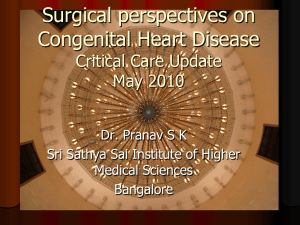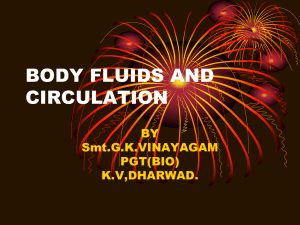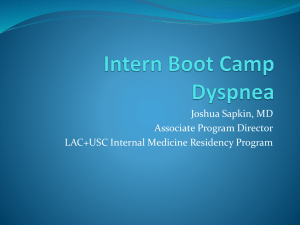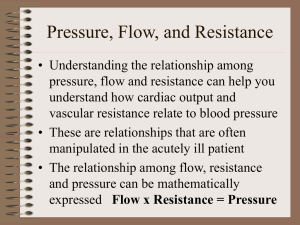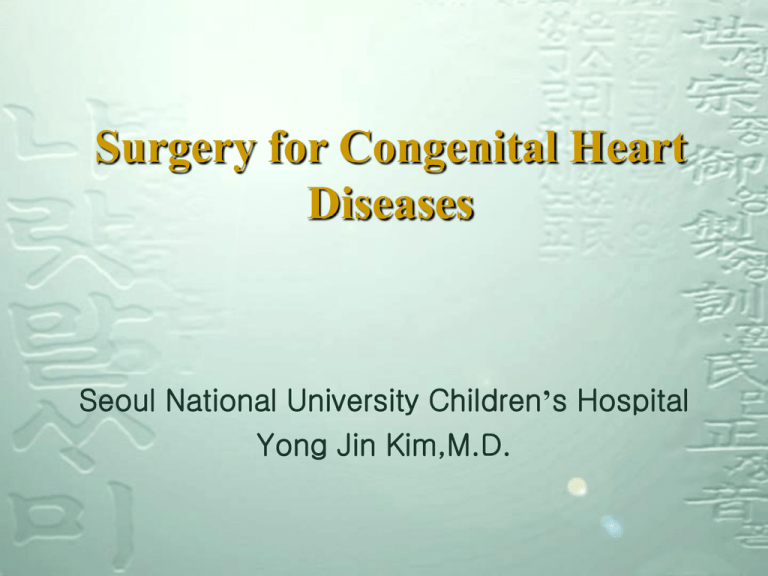
Surgery for Congenital Heart
Diseases
Seoul National University Children’s Hospital
Yong Jin Kim,M.D.
Etiologic Basis of Congenital Heart
Diseases
1. Primary genetic factors
(10%)
1) Chromosomal
;
5-10%
2) Single mutant gene
;
3%
Recessive
Dominant
2. Genetic-environmental interaction
(90%)
1) Multifactorial inheritance
;
majority
2) Risks to offspring of an affected parent
3) Environmental contribution
Drugs
Infections
Maternal conditions
Potential Cardiovascular Teratogens
1. Drugs
Alcohol
Amphetamines
Anticonvulsants
Chemotherapy
Sex hormone
Thalidomide
Retinoic acid
2. Infections
Rubella
Coxsakie virus
3. Maternal conditions
Old age
Diabetes
Lupus
Phenylketonuria
4. Others
Maternal Risk Factors
Factors
Malformation
Advanced age
Trisomy 21
Maternal CHD
Various
Diabetes mellitus
VSD, TGA, cardiomyopathy
SLE
Heart block
Phenylketonuria
TOF, VSD, COA, HLHS
Viruses
Teratogenic, myocarditis
(*cytomegalovirus,
herpes, coxsacki B,
parvovirus)
Maternal Drug Exposures
•
•
•
•
•
•
•
Drug
Malformation
Diphenylhydantoin
Trimetadione
Thalidomode
Lithium
Alcohol
Amphetamine
Birth control pills
PS, AS
VSD, TOF, TGA, HLHS
TOF, Truncus arteriosus
Ebstein anomalies
VSD, ASD, PDA, TOF
VSD, ASD, PDA, TGA
VSD, TOF, TGA
Stages of Heart Formation
1. Early blood vessel formation
1) Intraembryonic blood vessel at 13 days
2) Extraembryonic blood vessels at 17 days
2. Development of heart
1) Position and cardiac tube at 23 days
Heart beating at 26 days.
2) Formation of heart loop at 8 somites
3) Formation of ventricle
4) Development of sinus venosus
3.
4.
5.
6.
Formation of
Formation of
Formation of
Formation of
cardiac septa
cardiac valves
arterial system
great systemic veins
Incidence of Congenital Heart Diseases
1.
Lt to Rt Shunt
PDA
ASD
VSD
AVSD
Abn. PV return
( 53 % )
17 %
16.5 %
13 %
3.5 %
3 %
2. Rt to Lt Shunt
TOF
TA
PA+VSD
PA+IVS
(11 % )
4.5
3
2.5
0.5
3. Admixture Lesion
TGA
Univ. Ht.
Atrial isomerism
DORV
Truncus
Corrected TGA
%
%
%
%
( 15 % )
5 %
5 %
<2 %
<2 %
0.8 %
< 0.5 %
4. Obstructive Lesion
Coarctation
PS
MS etc.
LVOTO
HLHS
IAA
5. Valvular Lesion
Ebstein
AR
MR
SV aneurysm
6. Miscellaneous
Arrhythmia
Vascular ring
( 15 % )
9.5 %
2 %
1.5 %
1.3 %
0.9 %
0.6 %
<1 %
< 0.5 %
< 0.5 %
< 0.5 %
5 %
0.5 %
Evaluation of CHD by History Taking
1. Infants
1) Murmur
2) Symptoms of CHF
poor feeding,
low weight gain,
tachypnea, tachycardia,
sweating, anxiety,
irritability, frequent URI
3) Symptoms of hypoxemia
cyanosis, hypoxic spell
2. Children
1) Murmur
2) Symptoms of CHF
exercise intolerance,
dyspnea on exertion,
frequent URI,
palpitation
3) Syncope, chest pain
4) Symptoms of Hypoxemia
cyanosis,
hypoxic spell,clubbing
To Be Corrected in Neonate
Critical AS
Hypoplastic left heart syndrome
Mitral valve hypoplasia
Aortic valve and arch hypoplasia
Hypoplastic left ventricle
Interrupted aortic arch
Symptomatic COA
TGA
Obstructive TAPVC
Truncus Arteriosus
PA with IVS
PA with VSD
Other symptomatic complex heart diseases
To Be Corrected in Infancy(I)
Cardiac anomalies with pulmonary outflow
tract obstruction
•
•
•
•
•
•
•
•
•
Double inlet ventricle
Critical PS
Tricuspid atresia
DORV
DOLV
TGA
TOF
PA with or without VSD
Corrected TGA
To Be Corrected in Infancy(II)
Cardiac anomalies with CHF
Large VSD
AVSD
Double inlet ventricle
Tricuspid atresia
TAPVC
COA
DOLV
PA with IVS
Corrected TGA
Cardiac mass
TGA
Truncus arteriosus
Severe AS, AR
Severe MS, MR
Interrupted aortic arch
DORV
Aortopulmonary window
ALCAPA
PDA
TAPVR
To Be Corrected in Infancy & Childhood
ASD
AS(LVOTO)
Partial AVSD
Ebstein’s anomaly
VSD with PS
VSD
PS
Mitral stenosis
Atrial isomerism
Coronary artery anomaly (A-V fistula)
Anomalous pulmonary venous drainage
Valvular heart diseases
Complex anomalies with previous palliation
Late presenting cardiac anomalies
Cardiomyopathy
Surgical Indications
and
Optimal Timing of Operation
Palliative Surgery
Systemic – pulmonary artery shunt
Blalock-Taussig shunt
Unifocalization and shunt
Cavopulmonary shunt (BCPS)
RVOT reconstruction
Valvotomy
Patch widening
Valved conduit
Pulmonary artery banding
Atrial septectomy
Systemic–Pulmonary Artery Shunt
Systemic–pulmonary artery shunt is indicated due to
age, size, anatomy or other conditions when:
Complex anomaly with severe cyanosis, irritability,
hypoxic episode
Critically ill neonates or infants due to decreased
pulmonary flow
Facilitating growth of hypoplastic pulmonary artery
Pulmonary Artery Banding
Pulmonary artery banding is indicated to decrease
pulmonary blood flow & protect vascular disease
when:
Control of congestive heart failure
Complex or multiple VSD (+/- coarctation)
Single ventricle, Tricuspid atresia without PS
CPB medically contraindicated
Protection of pulmonary vascular bed
Single ventricle – Fontan operation
Preparation of LV for arterial switch operation
TGA with IVS / restrictive VSD
Atrial Septectomy
For the increasing of effective pulmonary
flow and systemic oxygen saturation
Indication of atrial septectomy :
TGA
Tricuspid atresia
Pulmonary atresia + IVS
MV and LV hypoplasia
Decreasing tendency of indication due to
early total correction or intervention
Reparative Surgery
Non-open heart surgery
Open heart surgery
Palliative procedure
Corrective procedure
Anatomic correction
Physiologic correction
Non-open Heart Surgery
Palliative procedure
Corrective procedure
PDA
COA
Vascular ring and sling
Coronary artery anomalies
Stenotic valvular diseases
Inflow occlusion technique
Instrumental dilatation
Patent Ductus Arteriosus
Open communication usually between upper
descending Ao and proximal portion of LPA
Significant PDA : indicated after 1st month
Prophylactic closure : 6-12 mo
Sx of heart failure or failure to thrive :
indicated at any time
Severe pulmonary vascular disease :
contraindicated
Coarctation of the Aorta
Congenital narrowing of upper thoracic aorta adjacent
to the ductus arteriosus
Operation is indicated when :
Reduction of luminal diameter > 50%
Upper body HT > 150mmHg in young infant
With CHF at any age
COA with VSD
Two stage repair
One stage repair
COA with other important intracardiac defects
One stage repair
Vascular Ring
Anomalies of the great arteries that compress the
trachea or esophagus
Double aortic arch
Rt aortic arch with retroesophageal anomalous Lt. SCA
and ligamentum arteriosum
Rt aortic arch with retroesophageal ligamentum
arteriosum
Operation is indicated when : Obstructive Sx and
radiologic signs of obstruction
Division by thoracotomy
CPB in associated cardiac anomaly
Vascular Sling
Lt. pulmonary artery arises anomalously from
Rt pulmonary artery extrapericardially, form a
sling around trachea
Sx & Signs of obstruction : indicated
Tracheal anomaly or other airway problems (+)
(ASD, VSD, PDA, Lt SVC)
Thoracotomy without CPB
Median sternotomy with CPB
Open Heart Surgery
ASD and PAPVR
A hole of variable size in the atrial septum and is
most common cardiac malformation with various
location of defect, fossa ovalis, posterior, ostium,
primum, coronary sinus, subcaval (sinus venosus)
Uncomplicated ASD or of PAPVC with RV volume
overload (Qp/Qs>1.5 or 2.0) : an indication
Scimitar syndrome
Isolated PAPVC
Optimal age : under 5 years but recently 1-2 years
to avoid RV volume overload
Unroofed Coronary Sinus Syndrome
A spectrum of cardiac anomalies in which part or all of the
common wall between the coronary sinus and left atrium is
absent
Operation is advisable with diagnosis when
With persistent Lt SVC
Arterial desaturation
Risk of cerebral embolism
Good results of operation
Without persistent Lt SVC(Coronary sinus ASD)
Same as for other type ASD
Associated with other major cardiac anomalies
Clear indication for operation
Total Anomalous Pulmonary
Venous Connection
These are no direct connection between any
pulmonary vein and the LA. But rather, all the
pulmonary veins connect to the RA or one of its
tributaries
Dx is an indication of operation
Immediate repair with Dx in any ill neonate :
Preop preparation is not needed
Repair should be done nearly always before 6 mo
Dx at 6-12 mo : prompt repair is indicated
Ventricular Septal Defect
A hole (or multiple holes) between Lt & Rt ventricle
•
•
•
•
•
Symptomatic large VSD : an indication of operation
Before 3 mo : indicated in large VSDs with CHF or
respiratory symptoms
Moderate sized VSDs (Qp/Qs < 3.0) with few
symptoms : observation during infancy
Small VSDs (Qp/Qs < 1.5) :
not indicated, risk of bacterial endocarditis
Subarterial type : early repair is indicated before
childhood
Atrioventricular Septal Defect
Abnormalities of atrioventricular valve form
& function and interatrial & interventricular
communication from maldevelopment of
the endocardial cushions
Presence of AVSD : indicated with Dx
•
•
•
•
Partial AVSD : 1-2 years of age except CHF or
growth failure
Complete AVSD with good condition : 3-6 mo
Complete AVSD with refractory CHF or respiratory
Sx : indicated promptly
Development of pulmonary vascular obstructive
disease : not indicated
Congenital Aortic Stenosis
The various forms of LVOTO occur in combination with
other cardiac lesions (IAA, COA, MV anomalies, LV
hypoplasia) and obstructive types are supravalvular,
valvular, subvalvular, intraventricular
•
•
Critical AS in neonates : urgent (severe CHF, LV
dilatation, hypertrophy)
Infants and children
Pressure gradient > 75mmHg
Sx of angina, syncope, exercise intolerance, LVH,
pressure gradient > 50mmHg
Pressure gradient over 40mmHg in subvalvular lesion
to prevent progression
Aortopulmonary Window
Abnormal development of aortopulmonary
septum caused by incomplete formation of
the right and left conotruncal ridges.
Symptomatic AP window is an indication
•
•
•
Symptomatic infants : indicated with Dx
Repair is advised before 3 mo of age (size,
increased shunt, pulmonary hypertension)
Old children should be operated on unless PVR
render them inoperable
Aneurysm of Sinus of Valsalva
Thin walled, tubular outpouchings, nearly always Rt
sinus or adjacent half of the noncoronary sinus and
with an entirely intracardiac course, that may rupture
into the right (rarely left) heart chamber to form a fistula
•
Ruptured sinus of Valsalva : indicated promptly
because of abrupt development of CHF
With VSD or VSD+AI : prompt repair is indicated
Large aneurysms producing hemodynamic
derangement : indicated
Small and moderate sized aneurysm without symptom :
not indicated
•
•
•
Cor Triatriatum
A rare congenital cardiac anomaly in which pulmonary
veins typically enter a proximal left atrial chamber
separated from the distal left atrial chamber by a
diaphragm in thich there are one or more restrictive
ostia (sinister, dexter)
Indication for operation
Restrictive aperture in the partition is an urgent
indication
Symptoms usually develop early, and operation is
necessary in the 1st year of life
Life expectancy after repair in infancy is excellent
•
•
•
Congenital MS and MR
•
•
•
•
•
A developmental malformation of one or more of the
components of MV apparatus, including LA wall
adjacent insufficiency or a combined lesion
Infancy
Mild and moderate Sx without MVR :
Supravalvular ring, commmissural fusion
Other circumstances : only for infants with heart failure
Childhood
Considerations for operation are similar CHF
Severe pulmonary HT
MVR should be withheld whenever possible
Ebsteins anomaly
A congenital defect of tricuspid valve in which the origin of
septal and posterior leaflets or both are displaced downward
into the right ventricle and the leaflets are variably deformed
Symptomatic Ebstein’s anomaly is an indication
• Neonates presenting in extremes :
Starnes procedure in first week
• Valve repair and ASD closure :
with important TR
moderate and severe cyanosis
• WPW syndromes :
ablation of accessory conduction pathway
Pulmonary Stenosis
•
•
•
A form of RV outflow obstruction in which stenosis is
usually valvar or both valvar & infundibular or only
infundibular
Critical PS in neonate : indicated with Dx
Percutaneous balloon valvotomy
Valvotomy with CPB
Transannular RVOT patch widening
Valvotomy with inflow occlusion technique
PS in infants and children : indicated with Sx & Pr
gradient over 50mmHg
Surgical treatment is not indicated with mild stenosis
PA with Intact Ventricular septum
A cardiac anomaly in which the pulmonary valve
is atretic, coexisting with variable degree of right
ventricle and tricuspid valve hypoplasia
Dx is an indication of operation
•
Size of the TV : Z-value of the tricuspid valve
< -4 --- Systemic-pulmonary artery shunt
-2~-4 --- RVOT patch + shunt
> -2 --- RVOT patch
•
Evaluation after 6-12 mo after initial procedure :
Two ventricle repair
One and half ventricle repair
Fontan procedure
Tetralogy of Fallot
Characterized by underdevelopment of RV
infundibulum with anterior and left ward
displacement
Dx is an indication of operation
•
•
•
Symptomatic complicated in early life :
Early total correction or
Shunt (1-2 mo) and total correction (1 year)
Asymptomatic uncomplicated :
Total correction at 3-24 mo
Multiple VSDs, LAD from RCA :
Initial shunt and total correction
Pulmonary Atresia with VSD
These are no luminal continuity between RV
& pulmonary trunk among the group of TOF.
It is usually congenital, but may be acquired.
Dx is an indication of operation
•
•
•
Confluent and normally distributing PAs:
Complete repair in early life
Palliation and repair (3-5 year) with conduit
Confluent PAs distributing to the major segments :
Pul. Segments > 15 --- need not unifocalization
repair with conduit in 3-5 years
Nonconfluent PAs distributing to the minor segment :
Mmultistage operation with unifocalization
Palliative shunt only
Double Outlet Right Ventricle
A congenital cardiac anomalies which both great arteries
rise wholly or in large part from the RV. It is, then, a type
of ventriculoarterial connection.
Dx is an indication of operation
• Simple DORV with subaortic VSD : repair by 6 mo
with PS --- repair like TOF
• DORV with subpulmonic VSD (Taussig-Bing heart) :
arterial switch operation within 1 mo
with PS --- REV or Rastelli operation at 3-5 years
• DORV with noncommitted VSD :
VSD enlargement and intraventricular tunnel
Fontan operation
Transposition of Great Arteries
A cardiac anomaly in which the Ao arises entirely or in large
part from the RV, and PA from LV (atrioventricular concordant
connection and ventriculoarterial discordant connection)
•
Simple TGA in neonate :
arterial switch operation within 1 mo
Simple TGA beyond 30 days :
rapid two-stage operation
atrial switch operation (Mustard, Senning)
TGA with VSD :
arterial switch operation as early
TGA with VSD and LVOTO
Lecompte operation at 6-18 mo
Rastelli or Lecompte operation at 3-5 years
•
•
•
Tricuspid Atresia
A cardiac anomaly in which RV fails to open into a
ventricle through a AV valve. There is thus a
univentricular AV connection
PVR is an important indicator
•
•
> 4 unit -- contraindicaton
2-4 unit -- BCPS
< 2 unit -- Fontan operation
Symptomatic in early life
early shunt or PAB
BCPS or hemi-Fontan at 6-12 mo
Fontan at 12-24 mo
Nonsymptomatic
Fontan candidate : 12-30 mo
Double Inlet Ventricle
A cardiac anomaly in which both atria connect to only
one ventricular chamber by either two separate AV valve
or a common AV valve
Dx is an indication of operation
•
•
•
Septation : 1-2 years
enlarged dominant ventricle
two competent nonstenotic AV valve
no pulmonary or systemic outflow obstruction
Fontan operation : 1-2 years
< 3-5 mo
--- systemic outflow obstruction
6 - 12 mo
--- BCPS
1 – 2 years --- Fontan operation
Cardiac transplantation
Interrupted Aortic Arch
Complete luminal and anatomic discontinuity between
two segments of the aortic arch, and generalized
narrowing of LVOT, posterior malalignment, muscle of
Moulaert, small aortic annulus, aortic hypoplasia
Dx is an indication of operation
•
•
•
•
Coexisting cardiac anomaly : not contraindication
One-stage repair : preferred
Two-stage repair : in complicated intracardiac
anomalies
Single ventricle associated : alternative plan
Hypoplastic Left Heart Syndrome
A wide spectrum of cardiac anomaly with various degree
of hypoplasia of the structure of the left side of the heart
Dx is an indication of operation
•
First stage palliation : 1-30days
Norwood operation
•
Second stage palliation : 6-12 mo
BCPS
Hemi-Fontan
•
Third stage correction : 18-24 mo
Completion Fontan
•
Cardiac transplantation :
Aortic diameter < 2.5 mm
Truncus Arteriosus
•
•
•
A cardiac anomaly in which one great artery,
arising from the base of the heart by way of a
truncal valve, PAs proximal to the origin of the
brachiocephalic branches.
Presence of truncus arteriosus : an absolute
surgical indication.
Neonatal repair is recommended :
Homograft interposition
Prosthetic valve conduit
Autologous tissue reconstruction
Repair should be done before 6 mo
Pulmonary vascular obstructive disease :
contraindication
Congenitally Corrected TGA
A cardiac anomaly with ventriculoarterial discordant
connection & atrioventricular discordant connection. The
circulatory pathways are therefore in series
The presence of CCTGA per se is not an indication.
With VSD : indications for VSD
With VSD + PS : indications for TOF
Isolated TR : indication for MR
With complete heart block : pacing
Fontan procedure indicated :
straddling tricuspid valve
complete AVSD
left sided tricuspid valve incompetence
Double Switch operation : anatomic correction
•
•
•
•
•
•
Anatomically Corrected Malposition
of Great Arteries
A cardiac anomaly in the position of the great
arteries and not in cardiac connection.
The LV probably always exhibits a well formed
subaortic conus and the RV has less well
developed infundibulum than normal
•
Diagnosis is not an indication for operation
Coexisting cardiac anomalies are indications
Large VSD always present
Pulmonary stenosis is usual
Subaortic stenosis may occur
Tricuspid atresia or TV hypoplasia in half
•
Double Outlet Left Ventricle
A cardiac anomaly in which both great arteries arise from the
left ventricle with nearly always with large VSD, and frequent
occurrence of PS.
Dx is an indication for op.
Without PS :
Performed in the 1st 6mo of life
Banding and delayed repair
Intracardiac baffling
Conduit repair
With PS :
Classic shunt before the age of 2 years
Simple intraventricular repair
LeCompte procedure in infancy
Conduit repair in childhood
•
•
Coronary Arteriovenous Fistula
Direct communication between coronary artery and lumen of
any one of cardiac chamber, or coronary sinus, or its
tributary veins, or SVC, PAs, or Pulmonary veins close to the
heart
Indicated unless the shunt is small (Qp/Qs<1.3)
Increase in size
Sx and heart failure
SBE
Low probability of spontaneous closure
Safety and efficacy of operation
Techniques
• Suture ligation without CPB
• Closure of transcoronary artery with CPB
• Transcardiac chamber closure with CPB
Anomalous LCA From the PA
Whole of the left main or LAD, or circumflex branch connects
anomalously to main pulmonary artery or rarely from proximal
RPA. Very rarely, both coronary arteries connect to the
pulmonary artery by a single trunk.
Urgent operation is indicated in infancy. The condition is an
also indication for op in older patient as well.
• Construction of a two coronary system
LCA transfer
CABG
Subclavian-left coronary anastomosis
Tunnel operation
• Ligation of LCA
Atrial Isomerism
A condition which the right sided and left
sided atria, normally morphologically different,
are morphologically similar.
Surgical treatment is indicated with coexisting
anomaly, not by the atrial isomerism.
Intraventricular complex repair
Complex atrial baffling
Fontan type repair
Palliative operation
•
•
•
•
Cardiac Transplantation
Indications
Cardiac diseases that has a poor prognosis for short-term
survival(<1 year) and that is not treatable by conventional
therapy
Contraindications
•
Severe and life-limiting coexisting medical problems
Active bacterial or viral infection
Psychosocial family situation
Presence of severely elevated PVR (>8 Wood Units)
Immunologic status of the recipient panel-reactive antibody
(PRA) > 25%
•
•
•
•



